A Thorough Comparison of Different Light Emitting Diode Video Screen Technologies and The Applications
A Thorough Comparison of Different Light Emitting Diode Video Screen Technologies and The Applications
Blog Article
LED display walls are increasingly common in various environments, including music events, athletic competitions, as well as business presentations. These large displays are composed of many individual Light Emitting Diode modules which work together to create a cohesive cohesive visual. Various multiple kinds of Light Emitting Diode video wall technologies available, each with its unique characteristics as well as advantages. Grasping these options can assist companies as well as entities select the appropriate solution for their specific needs.
One frequent kind of LED display screen technology is the direct view LED. Such technology uses individual LED units which are placed closely in proximity to create a large screen. Direct view LED screens are recognized for their elevated brightness and vibrant colors, making them perfect for external events or brightly lit environments. They also have a wide sight perspective, which means that viewers can view the display clearly at various locations. Such renders directly viewed Light Emitting Diode walls a favored option for stadiums as well as external festivals.
A different type of LED video wall solution is the LED-backlit Liquid Crystal Display. This solution merges conventional Liquid Crystal Display displays with LED illumination for improved brightness and color accuracy. LED illuminated Liquid Crystal Displays are often used in indoor environments, including retail malls and meeting spaces. These displays provide superior image clarity and are typically more cost-effective than direct view LED screens. Nonetheless, they may not perform as effectively in well-lit settings, since the backlighting can sometimes wash out the colors.
A third option is the Organic Light Emitting Diode display screen. Organic Light Emitting Diode technology offers superior contrast and hue richness compared to other types of displays. Each pixel in an Organic Light Emitting Diode display produces its individual luminescence, enabling for genuine dark tones and lively colors. Such renders Organic Light Emitting Diode display screens especially attractive for applications that require high-quality images, including gallery galleries and high-end shopping outlets. However, Organic Light Emitting Diode technology can be more costly and may often be as luminous as direct view Light Emitting Diode walls, making it less suitable for external applications.
Along with the aforementioned technologies, there are also multiple uses for Light Emitting Diode video walls. These displays can be utilized for promotion, entertainment, and data presentation. For instance, businesses often utilize Light Emitting Diode video walls for electronic signage to attract clients as well as promote products. Within amusement, they enhance the visual encounter at music events and events, offering lively backdrops and engaging images. Within corporate led video wall troubleshooting settings, Light Emitting Diode video walls can be utilized for demonstrations, video conferencing, as well as educational sessions, aiding to communicate information in a aesthetically attractive way.
In conclusion, Light Emitting Diode display walls are available in various technologies, each having its own advantages as well as applications. Direct view LED walls are great for external applications, while LED illuminated Liquid Crystal Displays are more suitable for interior settings. OLED display screens offer exceptional visual clarity but may be at a greater cost. Grasping the differences variations can assist entities to make informed choices about the best kind of Light Emitting Diode display wall most satisfies their needs, whether it be for advertising, entertainment, or business applications.